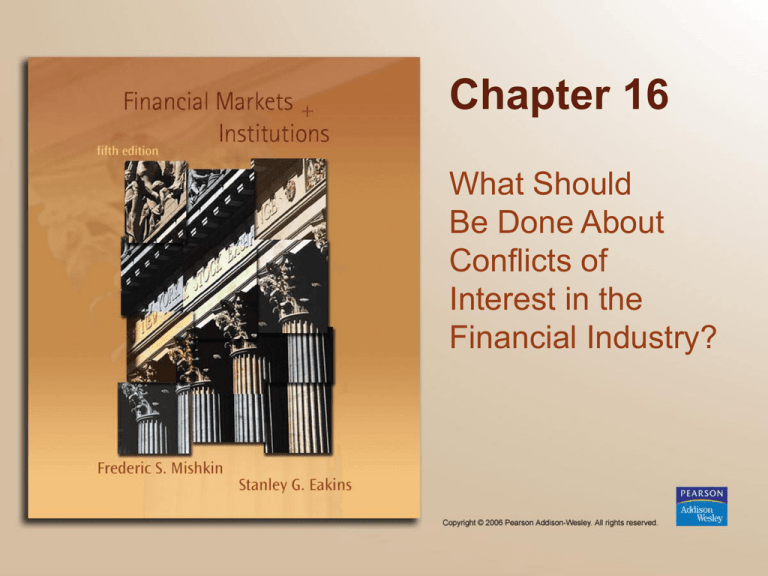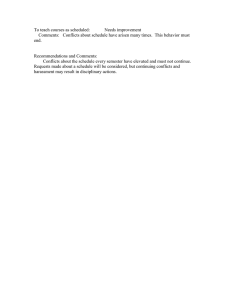
Chapter 16
What Should
Be Done About
Conflicts of
Interest in the
Financial Industry?
Chapter Preview
• We examine recent equity market scandals and
the consequences on the investing public. We
pose a broad question: what can be done to
resolve these problems? Topics include:
– What Are Conflicts of Interest and Why Are
They Important?
– Ethics and Conflicts of Interest
– Types of Conflicts of Interest
– When Are Conflicts of Interest a Serious Problem?
– A Framework for Evaluating Policies to Remedy
Conflicts of Interest
Copyright © 2006 Pearson Addison-Wesley. All rights reserved.
16-2
What Are Conflicts of Interest
and Why Are They Important?
• Financial intermediaries engage in a variety
of activities to collect, produce, and
distribute information. By providing multiple
services, they realize economies
of scope.
• However, these services may be competing
with one another, and this creates the
potential for a conflict of interest.
Copyright © 2006 Pearson Addison-Wesley. All rights reserved.
16-3
What Are Conflicts of Interest
and Why Are They Important?
• The conflicts of interest may arise as the
concealment of information for the dissemination
of misleading information.
• We care about these conflicts of interest because
a reduction in the quality of information increases
the presence of asymmetric information. The
problems therein were just discussed in the
previous chapter.
Copyright © 2006 Pearson Addison-Wesley. All rights reserved.
16-4
Ethics and Conflicts of Interest
• Conflicts of interest generate incentives to
provide false or misleading information.
This behavior is considered unethical.
• One way to limit these conflicts is to make
workers aware of the ethics issues at stake,
so that they are less likely to engage in
unethical behavior.
Copyright © 2006 Pearson Addison-Wesley. All rights reserved.
16-5
Types of Conflicts of Interest
We will discuss, in turn, four areas of financial
service activities that harbor the greatest potential
for generating conflicts of interest. These are:
– Underwriting and research in investment banking
– Auditing and consulting in accounting firms
– Credit assessment and consulting in
credit-rating agencies
– Universal banking
Copyright © 2006 Pearson Addison-Wesley. All rights reserved.
16-6
Underwriting and Research
in Investment Banking
• Some investment banks both underwrite
new securities sold the public as well as
prove research (buy recommendations) to
the investing public
• When revenues from underwriting exceed
brokerage commissions, favorable
research will attract more business, at the
expense of unbiased recommendations to
the investing public.
Copyright © 2006 Pearson Addison-Wesley. All rights reserved.
16-7
Underwriting and Research
in Investment Banking
• In initial public offerings of equity,
underwriters direct the new shares as they
wish, typically to their best clients or
potential new clients.
• Since most IPOs are underpriced, many of
these shares are immediately sold for a
profit (called spinning). This immediate
“profit” may appear as nothing more than
payment for future business.
Copyright © 2006 Pearson Addison-Wesley. All rights reserved.
16-8
Auditing and Consulting
in Accounting Firms
• The role of auditors in public firms is to provide
an unbiased view of the financial reports to
reduce asymmetric information between the
firm’s management and the investing public.
• By also providing management advisory
services (such as systems support), the auditor
has an incentive to fudge the audit if the fees
from other services are substantial.
Copyright © 2006 Pearson Addison-Wesley. All rights reserved.
16-9
Auditing and Consulting
in Accounting Firms
• Auditors also have a conflict of interest
since they are paid by the firm they audit.
If the auditor gives an unfavorable audit
report, the auditor may lose the auditing
business as well.
• A well known case of the failure of auditors
to provide unbiased reports was Arthur
Andersen’s audit of Enron.
Copyright © 2006 Pearson Addison-Wesley. All rights reserved.
16-10
Credit Assessment and Consulting
in Credit-Rating Agencies
• Bond investors rely on credit-rating agency
assessment of firm’s debt (debt ratings).
• However, ratings are only provided when
the firm pays the agency. Agencies, then,
have an incentive provide “better” ratings to
attract business.
Copyright © 2006 Pearson Addison-Wesley. All rights reserved.
16-11
Credit Assessment and Consulting
in Credit-Rating Agencies
• Rating agencies have also started
providing firms with other services, and
have the same conflicts as auditors in
this regard.
Copyright © 2006 Pearson Addison-Wesley. All rights reserved.
16-12
Universal Banking
• Universal banking refers to institutions
that provide some combination of
commercial banking, investment banking,
and insurance services.
• Glass-Steagall prohibited this in the U.S. as
of 1933. However, in 1999, Congress
repealed this act, allowing for some form of
universal banks in the U.S.
Copyright © 2006 Pearson Addison-Wesley. All rights reserved.
16-13
Universal Banking
• Issuers that use the underwriting services
of a bank will also benefit from sale of its
products to the banks other (retail)
customers. Customers should expect
unbiased advice, but may not get it.
• Bank managers may push investing
products of its affiliates, even if they aren’t
in customer’s best interest.
Copyright © 2006 Pearson Addison-Wesley. All rights reserved.
16-14
Universal Banking
• Lenders with private (bad) information have
an incentive to withhold the information
during security issuances in order to get
paid themselves, at the expenses of the
investing public.
• Lenders may offer favorable terms to
secure future underwriting business.
Copyright © 2006 Pearson Addison-Wesley. All rights reserved.
16-15
Universal Banking
• Banks may use strong-arm tactics to sell its
affiliate insurance products.
Copyright © 2006 Pearson Addison-Wesley. All rights reserved.
16-16
When Are Conflicts of Interest
a Serious Problem?
• Conflicts of interest are a problem
when they lead to a decreased flow of
reliable information (increased
asymmetric information).
• However, even with potential conflicts, the
incentives (financial gain) may not be
present to actually act on them.
Copyright © 2006 Pearson Addison-Wesley. All rights reserved.
16-17
When Are Conflicts of Interest
a Serious Problem?
• Empirical evidence suggests that rating
agency debt ratings are unbiased, despite
being paid by the firms.
• Underwriting and commercial banking also
appeared to be free from exploitations.
Many banks in then 1920s spun-off their
investment banking activities to separate
the functions.
Copyright © 2006 Pearson Addison-Wesley. All rights reserved.
16-18
When Are Conflicts of Interest
a Serious Problem?
• Empirical evidence also suggests that the
investing public “discounts” recommendations
made by the underwriter’s analysts.
• However, when temporary rewards to high (such
as the late 1990s), “trusted” firms may extract
reputational rents from the investing public by
seeking short-term gains at the expense of their
future reputation.
Copyright © 2006 Pearson Addison-Wesley. All rights reserved.
16-19
What Has Been Done to Remedy
Conflicts of Interest?
Two major policies were implemented
following the scandals of the late 1990s
and early 2000s. These are:
– Sarbanes-Oxley Act of 2002
– Global Legal Settlement of 2002
Copyright © 2006 Pearson Addison-Wesley. All rights reserved.
16-20
Sarbanes-Oxley Act of 2002
Passed following the public outcry over
corporate scandals. The act, in summary, has
the following six major components:
1. Established the Public Company Accounting
Oversight Board to supervise accounting firms.
2. Prohibited public accounting firms from engaging in
nonaudit services to a client it is also auditing.
3. Members of the board’s audit committee must
be independent.
Copyright © 2006 Pearson Addison-Wesley. All rights reserved.
16-21
Sarbanes-Oxley Act of 2002
Passed following the public outcry over
corporate scandals. The act, in summary,
has the following six major components:
4. Required the reporting of off-balance sheet
activities.
5. Appropriated additional funding for the SEC.
6. Increased the charges for white-collar crimes
and obstruction.
Copyright © 2006 Pearson Addison-Wesley. All rights reserved.
16-22
Global Legal Settlement of 2002
The was a settlement reached between the
New York Attorney General and several of the
largest U.S. investment banks. The key terms
of the agreement included:
1. Firms must severe the link between underwriting and
research activities.
2. Spinning is banned.
3. Firms must make public analyst recommendations
and target prices.
Copyright © 2006 Pearson Addison-Wesley. All rights reserved.
16-23
Global Legal Settlement of 2002
The was a settlement reached between
the New York Attorney General and
several of the largest U.S. investment
banks. The key terms of the
agreement included:
4. Brokerage firms required to obtain third-party,
independent research for their clients.
5. $1.4 billion in fines.
Copyright © 2006 Pearson Addison-Wesley. All rights reserved.
16-24
A Framework for Evaluating Policies
to Remedy Conflicts of Interest
A trade-off between potential conflicts of
interest and economies of scale exists.
Simply eliminating any potential conflict
may not be the best solution:
1. The existence of a conflict of interest does
not mean that the conflict will have
severe consequences.
2. Even if incentives to exploit conflicts are high,
eliminating the conflict may be worse if it
reduces the flow of reliable information.
Copyright © 2006 Pearson Addison-Wesley. All rights reserved.
16-25
Approaches to Remedying
Conflicts of Interest
• Leave It to the Market: an appealing
approach that relies on market forces, but
has the problem that the market has a
“short” memory for past problems.
• Regulate for Transparency: regulate
mandatory disclosure, even if it is more
costly than the information provided.
Copyright © 2006 Pearson Addison-Wesley. All rights reserved.
16-26
Approaches to Remedying
Conflicts of Interest
• Supervisory Oversight: force firms to
provide private information to a supervisor,
who can act on it as deemed necessary.
• Separation of Functions: separate those
functions that create conflicts, either within
firms or (in extreme cases) by not allowing
those functions within the same firm.
Copyright © 2006 Pearson Addison-Wesley. All rights reserved.
16-27
Approaches to Remedying
Conflicts of Interest
• Socialization of Information Production:
look to public funding for information
providers, such as credit agencies.
Copyright © 2006 Pearson Addison-Wesley. All rights reserved.
16-28
Chapter Summary
• What Are Conflicts on Interest and Why Are
They Important? We discussed the role of
information flow that may be affected by
conflicts of interest
• Ethics and Conflicts on Interest: we
discussed how conflicts of interest may
lead to unethical behavior and agued for
awareness of the potential conflicts
Copyright © 2006 Pearson Addison-Wesley. All rights reserved.
16-29
Chapter Summary (cont.)
• Types of Conflicts of Interest: we
reviewed potential conflicts in underwriting,
research, auditing, credit assessment, and
universal banking
• When Are Conflicts on Interest a Serious
Problem? We reviewed empirical evidence
suggesting that markets do take into
account known conflicts of interest
Copyright © 2006 Pearson Addison-Wesley. All rights reserved.
16-30
Chapter Summary (cont.)
• What Has Been Done to Remedy Conflicts
of Interest? The implications of the
Sarbanes-Oxley Act and the Global Legal
Settlement were reviewed
• A Framework for Evaluating Policies to
Remedy Conflicts of Interest: potential
remedies were suggested to address the
trade-off between the cost of conflicts and
the benefits of economies of scope
Copyright © 2006 Pearson Addison-Wesley. All rights reserved.
16-31




